by Leon Oscar Taylor, BEng, MEng
The following article was written in June 2018 and essentially deals with stormwater runoff affecting Grand Anse Beach. The article was submitted to the Physical Planning Unit, the Prime Minister’s Office, and the present Minister of Health. The article was written as a voluntary contribution by the author.
Introduction
No one seems to have been concerned with the appearance of a blue algae bloom on Grand Anse Beach which occurred in 2018 at both ends of the beach.
The presence of blue-algae green signals that polluted runoff with a high concentration of nutrients had gained access to the sea along the beach and was therefore posing an environmental hazard to swimmers, fish and what little coral that exists offshore.
The following article addresses the cause of the algae bloom and what was done in the past to eradicate it and what should be done at present. The article also highlights the failure of the stormwater runoff provisions at Silver Sands which presently remain in place.
Dealing with Blue Green Algae on Grand Anse Beach in the past
In 1986 there was an extensive blue-green algae bloom extending east and west of the stormwater outfall at Spice Island Inn restricting the use of the beach and posing a health hazard to swimmers and users of the beach. There were also several cases of E. coli infections of swimmers elsewhere along the beach. I was retained by the OAS to determine the cause of the algae bloom and to devise a scheme to abate and eradicate it.
Blue-green algae, although it may be mistaken for seaweed, is essentially a bacteria that feeds on itself and is caused by stormwater runoff with a high nutrient content (phosphates and nitrates) entering the sea. Blue-green algae blooms form and thrive where the sea is relatively calm and restricted.
At the time, septic tanks with soakaways were used for sewage disposal in the Grand Anse area, as there was no sewage system in place and the effluent from the soakaways naturally found its way to the storm drains and the beach outfalls especially in periods of heavy rains.
Furthermore, the open pasture behind the beach was used as a grazing ground for cows and was littered with cow faeces, a ready source of nutrients.
Having limited resources to work with, my approach was to increase the retention period of the water in the stormwater drain by damming the outfall at Spice Island Beach Resort. The dammed water at the outfall was then pumped to a series of wetland ponds in the open field at the present South St George Police Station where it was retained and polished by aquatic plants and then discharged into the sea. The cows were also banned from the pasture and the pasture cleaned up.
Given the success that was achieved in the short time that the scheme was in operation, I was commissioned by the OAS to design retention ponds for Silversands, that is the parcel of land on which the Silversands resort sits, but these were never built for reasons unknown. Because of the high stormwater runoff that discharges into the Silversands site, the ponds took up most of the low lying ground behind the beach.
The pollution problem at the Spice Island outfall and pollution of the sea at Grand Anse Beach was eventually solved when a sewage system was installed replacing the use of septic tanks for the hotels and businesses at Grand Anse Beach. The swampy area at Silversands remained and was effective to some degree in retaining and polishing the runoff from the extensive catchment area uphill of the site.
In 2018 blue-green algae blooms returned to the east and west ends Grand Anse Beach. Why?
The area west of the Spice Island Outfall
The blue-green algae bloom here started at the outfall and extended west to Journey’s End. The obvious answer is that the concentration of pollutants in the surface drain that runs to the outfall had increased.
One possible cause was that the drain running behind Spiceland Mall was recently cleaned for a significant portion of its length. The removal of the vegetation from the drain resulted in the loss of the ability of this vegetation to remove nutrients from the drain water and also slow down the flow of polluted drain water to the outfall, increasing the discharge of polluted water into the sea.
The outfall itself is badly damaged so that drain water was being discharged in the surf zone where it remains, rather than being discharged out to sea where it has a chance of being dispersed by the nearshore currents.
It is also possible that the recently built apartments across the road behind Spiceland Mall may not be connected to the sewage system and are using septic tanks, the runoff from which would be nutrient-rich and would find access to the drain behind Spiceland Mall and hence the outfall.
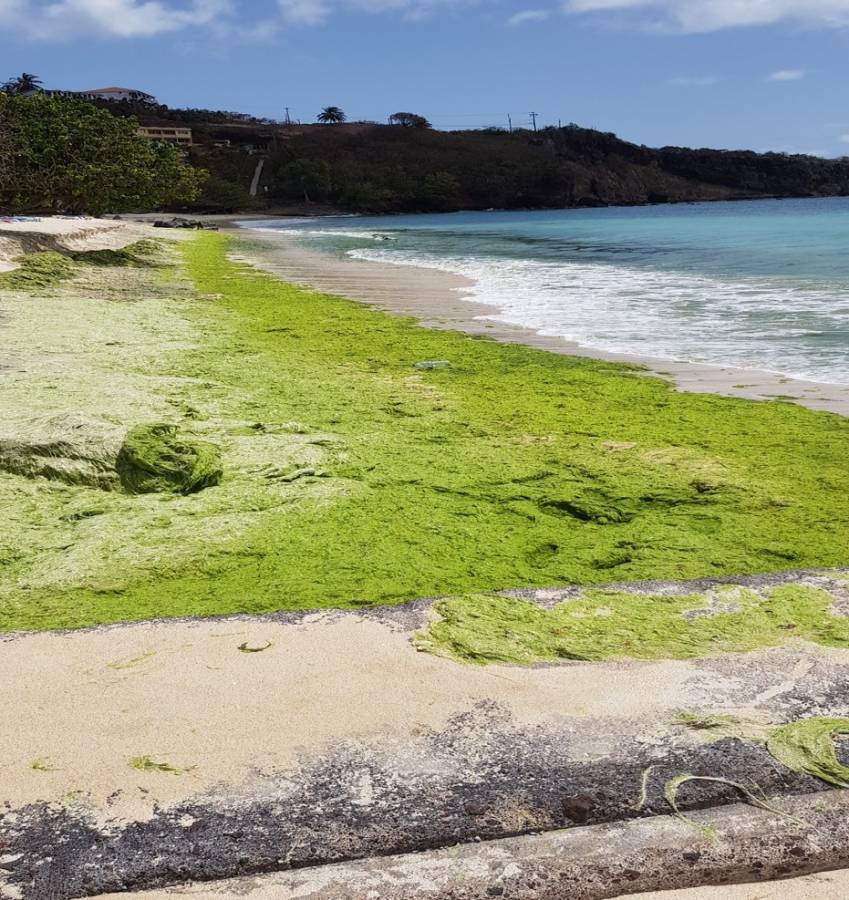
The photo above shows the blue-green algae bloom in June 2018 at the Spice Island Inn outfall. The blue-green algae extends to the end of the beach in the west. It appears to have been subsequently removed from the beach. However, removing the algae from the beach constitutes treating the symptom and not the cause.
The immediate steps required to alleviate the problem would be to repair and rebuild and extend if possible, the outfall. However, to go further, an investigation has to be conducted to determine if all buildings in the area are connected to the sewage system and the impact of those that are not. All buildings in the area should be connected to the sewage system if they are not.
The quality of the water in the storm drain and the seawater has to be determined and monitored and these measurements must be carried out on a regular basis.
Ultimately the solution for this area is the replacement of the open drain that surrounds the area by a stormwater sewage system with a proper outfall. Such a system is probably necessary now and it certainly should be considered before any further development takes place in the area extending from the Riviera site to Journey’s End.
Area extending from Radisson to the eastern end of Grand Anse Beach
This portion of Grand Anse Beach has 2 catchment areas, the largest of which drains into the Silversands site. The catchment area of the Silversands site roughly extends from the Falledge in the east to the Golf Course in the south and the ridge near the Catholic Church in the west.
The area extending from Silversands to the eastern end of the beach is of particular interest as this is the second location of the formation of a significant blue-green algae bloom. The beach west of Silversands appears to be free of the algae and is not considered in this article.
The blue-green algae Bloom at Silversands
The Silversands site in June 2018 was in the advanced stages of development into a 6-star luxury resort which will occupy the entire site including the original low lying swampy area which has been filled to accommodate the resort buildings This swamp no longer exists to retain and polish the stormwater and reduce the pollutants being discharged into the sea.
Apparently, an EIA study was prepared in advance of construction and recommended that measures were to be designed to clean the storm runoff before it entered the sea.
Subsequently, a Grenada Information Service (GIS) news bulletin titled “Silver Sands Installs Measures to Protect the Environment” quoted the head of the Architectural Firm of TVA Consultants as follows. “What we have done is to collect the debris before it gets to the sea. We take care of it ourselves through trash racks in our drains…we have silt traps within our drains so that the water that then goes out as was seen on the weekend is clear and that’s indisputable. “
There was no evidence of retention ponds or silt traps on the construction site when viewed from the main road. What is evident is that the runoff from the extensive catchment area which once discharged unto the Silversands swamp is intercepted by a concrete channel that runs along the western boundary of the site to an outfall structure constructed directly on Grand Anse Beach ending on the beach and not extending into the sea. The statement above by TVA therefore suggests that the trash racks and silt traps are located in the concrete channel but were not evident.
The concrete channel is approximately 4 feet wide and is flush with the existing ground level. It is not known how deep the concrete channel is. However, it is filled with broken rock to a depth of 2 feet below the top of the concrete channel.
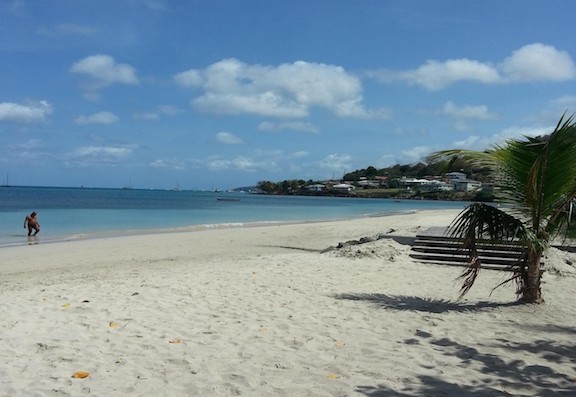
The outfall structure is partially covered by a 10 foot wide raised wooden platform with steps at either end, presumably to allow pedestrian traffic to cross it. The width of the concrete channel increases to 15 feet, approximately 40 feet from the wooden platform and ends 15 feet after its end. The crushed rock extends to the end of the widened concrete channel and ends in the sand on the beach.
Not knowing the details of the design of the outfall and its concrete channel, perhaps the crushed rock layer is intended to act as a silt trap and the runoff flowing in the crushed rock layer will filter through the beach sand. However, this is impractical since the interstices in the crushed rock layer are too large to remove fine material and the runoff reaching the outfall exit will be silt-laden, and the crushed rock layer will eventually be blocked by beach sand at its end and will permanently store runoff to its surface as seen in the photograph below.
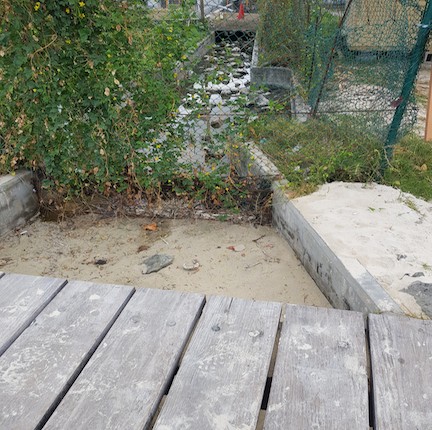
The effective depth of the concrete channel in periods of heavy rains and storms or for that matter when it conducts, water is therefore restricted to a depth of 2 feet, that is the distance from the top of the concrete channel to the surface of the crushed rock.
As a result, other than having trash and other debris removed, the discharge from the outfall will consist of untreated water with a high nutrient level capable of promoting the formation of a blue-green algae bloom. This water will be discharged directly on the beach eroding it before reaching the sea.
Confirmation of the above is to be found in the photograph below which shows the outfall discharge in June 2018 coincident with the first appearance of the blue-green algae in the sea at Silversands. The discharge water in the photograph below is certainly not clear and no doubt polluted.
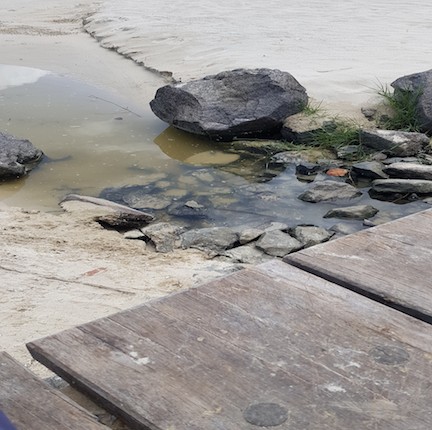
The beach erosion that is caused by the Silversands outfall even after moderate rains is shown below.
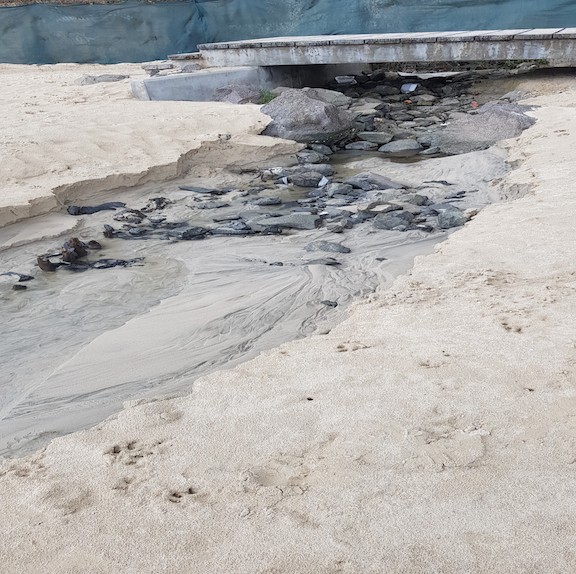
Given the above, not only is the Silversands outfall capable of polluting the sea, it is incapable of safely handling the runoff from its catchment area.
When storms or periods of high rainfall occur, the outfall is breached as is the beach forming a wide channel carrying silt-laden runoff across the beach and into the sea creating a plume that extends far out to sea as shown in the photographs below taken after a period of heavy rainfall in November 2016.
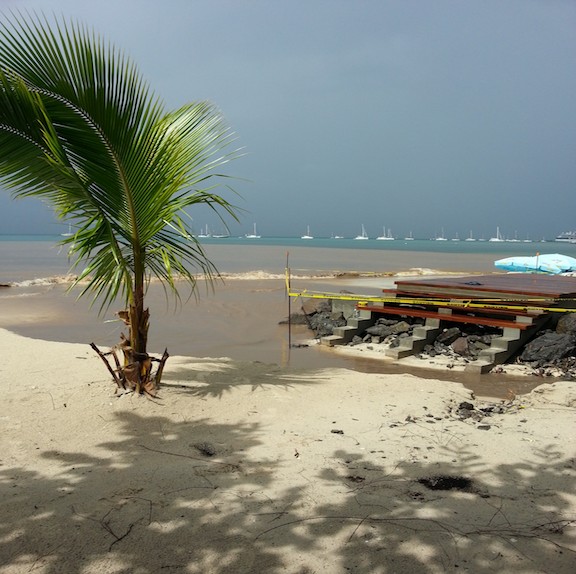
The extensive silt-laden plume created after storms seen in the photographs above not only destroys the beach and pollutes the sea, but it will destroy the offshore coral reefs if they still exist. Most importantly the outfall on the beach and its unsuccessful efforts to clean the runoff from the catchment area threaten the successful operation of the Silversands resort with its intended 6-star rating.
The outfall and measures taken to treat the runoff at Silversands have failed. The concrete channel and its outfall with its crushed rock layer are an environmental disaster because each time a period of heavy rains occurs, a plume of silt-laden water will be discharged into the sea recreating the conditions shown in the photos above. The water that remains in the crushed rock layer will become stagnant, promoting the growth of bacteria and algae and pose a health hazard. It is not known who was responsible for the design of the Silversands outfall and drain.
The solution to the problem at SilverSands now is both difficult and expensive. The site is surrounded by occupied private property, providing no opportunity to locate retention ponds. The only immediate practical solution seems to be the creation of a storm sewage system, but this requires a significant amount of detailed study and design and expense.
Nevertheless, the quality of the seawater in front of the outfall and the Silversands resort must be monitored as soon as possible to determine what dangers to swimmers exist.
Conclusions
Perhaps the blue-green algae blooms that threatened Grand Anse Beach in 2018, the island’s greatest environmental asset, is a lesson to be embraced. That is the provision of proper infrastructure must come before investment occurs.
Grand Anse Beach is in dire need of a stormwater sewage system before further investment of any significance can successfully occur without causing damage to the environment. This need must be addressed as a matter of urgency given the signs of development at the original Riviera hotel adjacent to Camerhogne Park. Where will stormwater runoff from this development be discharged? Will an outfall similar to that at Silversands be constructed on the beach? Such an occurrence will be a disaster for Camerhogne Park and the members of the public that use the park.
There is also need for the creation of a Master Plan for the area incorporating not only stormwater disposal but sewage treatment and transportation access.
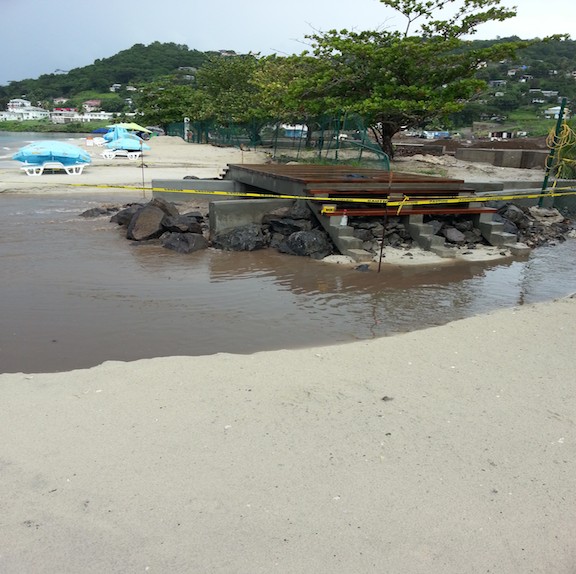









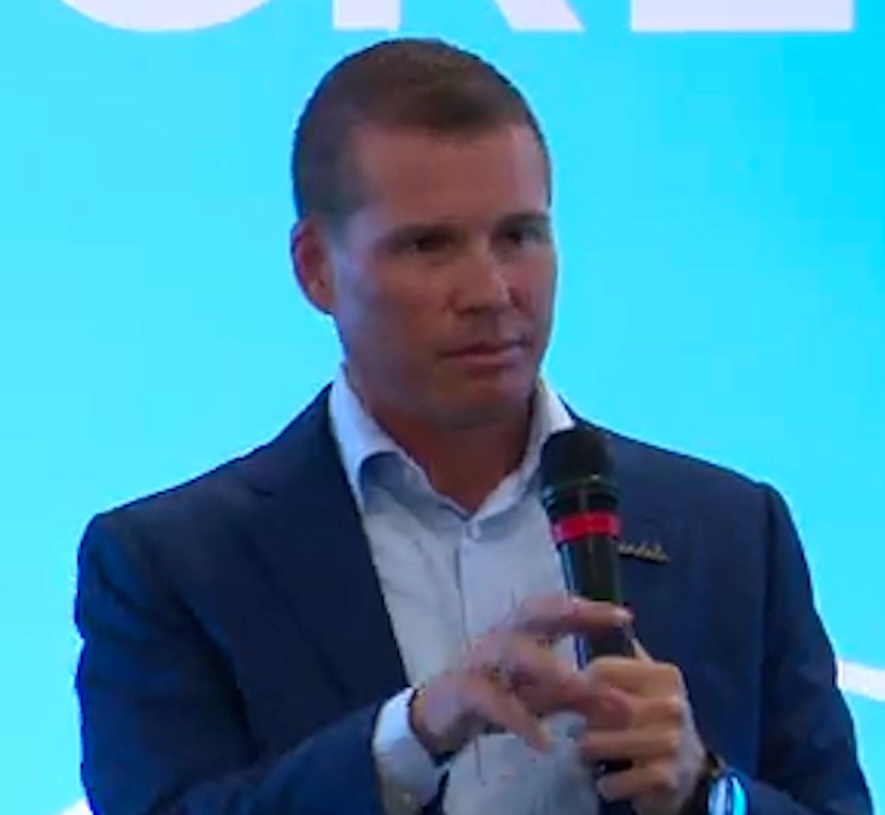









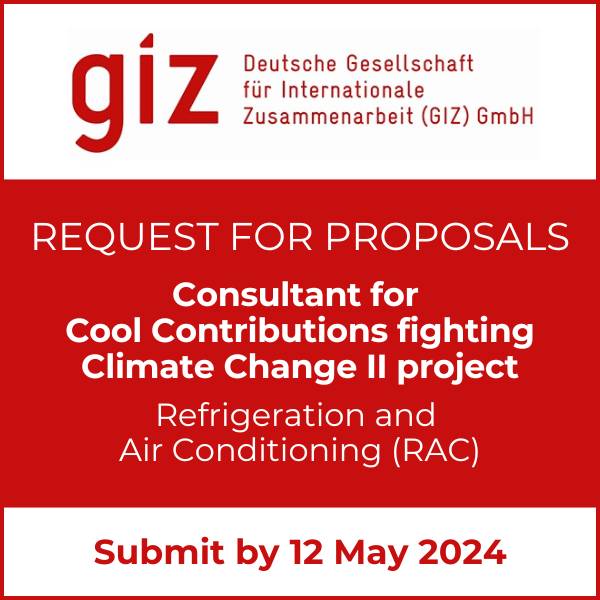




Excellent piece. Thanks Mr Taylor. And a timely reminder that action is needed now if one of Grenada’s much-advertised assets is not to become a health hazard to locals and tourists alike. Government must commission that master plan now and the big developments and hotels should be made to pay for most of it through taxes. And made to pay for its implementation in proportion to their water usage. This is a public health issue as well as a tourism issue and public health legislation could be used to enforce it. Time to get ahead of the game Grenada not wait for disaster.
They need to make sure to have underground pipes instead for proper drainage because the way the sand drain looks wont help anything. While Construction of Silversands they were suppose to make sure to have proper drainage for the beach.
The author has performed a valuable national service. Has such an expert analysis (on any topic), particularly one so finely worded, ever before appeared in a Grenadian publication?
The case he presents is damning. This is not just a matter of “asleep at the wheel”. Expediency ruled (and continues to rule). The rush to grab low lying fruit prevailed over responsible stewardship of the national treasure.
How high up does the buck stop? It is time for true patriots to speak up and act.